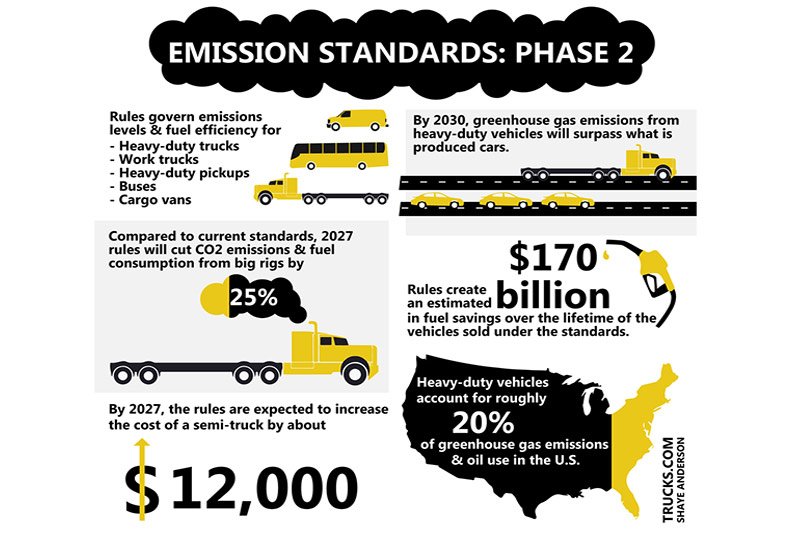Earth’s average surface temperature has risen about 2.12 degrees Fahrenheit since the late 19th century. The impact of these higher temperatures is apparent in the record number of extreme weather events in the U.S. and worldwide. The window to address these issues is rapidly closing, prompting governments worldwide to take drastic measures.
At the same time, fuel is the second-highest cost for most commercial trucking companies after labor. As a result, improving fuel economy is one of the most effective ways to increase profitability and strengthen bottom-line financial results. These dynamics provide a rare alignment of environmental and economic concerns.
Let’s examine the environmental cost of logistics, common sources of emissions, and how your fleet can reduce those emissions.
Fleets have many options to reduce emissions and improve their bottom line. Share on XEnvironmental Cost of Logistics
The U.S. is one of the top greenhouse gas producers in the world. According to the EPA, transportation accounts for about 27% of all emissions. Within transportation, medium and heavy-duty trucks account for roughly 24% of emissions. Transportation was also the fastest-growing source of emissions between 1998 and 2018.
There are several sources of preventable emissions:
- Idling: Heavy-duty truck idling wastes approximately one billion gallons of fuel each year in the U.S. alone. Surveys have shown that 70% to 80% of long-haul drivers idle their trucks for heating and air conditioning during their 10 hours off-duty.
- Driving: The best fuel economy happens at around 55 MPH, but many drivers are paid by the mile, meaning they prefer to go faster. At the same time, sudden acceleration at a high RPM can lead to excessive fuel consumption and emissions.
- Planning: According to the Census Bureau, 19% of all trucking miles occur with empty trailers. These statistics are higher for private fleets and independent carriers/owner-operators. Better planning could help reduce these wasteful empty miles.
The good news is that incentives are aligned for trucking companies to reduce their emissions. According to the ATRI, fuel costs represent one of the most considerable operational costs for operators, comprising between 25% and 39% of marginal expenses since 2008. Therefore, increasing fuel efficiency is in everyone’s best interest.
Strategies to Reduce Emissions
The commercial trucking and freight industry face a growing number of regulations designed to reduce emissions. For example, the EPA aims to cut heavy-duty truck CO2 emissions by about 270 million metric tons through stricter vehicle standards. At the same time, the SmartWay program provides strategies to increase fuel efficiency.

Phase 2 Emission Standards by the EPA – Source: Trucks.com
Aside from these mandates, three types of technological and financial innovations could help further reduce emissions.
#1. Alternative Energy Vehicles
There’s a growing push toward alternative energies within the commercial trucking industry. For example, the Tesla Semi, Nikola Two, and other projects aim to manufacture Class 8 Semis powered by lithium-ion batteries, hydrogen fuel cells, and other zero-emission technologies, reducing fleet operating costs and emissions.
The best starting point for electrification is often light- to medium-duty trucks that drive local routes. In addition to more accessible infrastructure, these trucks can take advantage of regenerative braking that occurs less frequently on highways. That said, fleets should begin the planning process for transitioning their heavy-duty trucks.
#2. Logistics Optimizations
Telematics for trailers and in-cab technologies like ELDs make it easy to track everything from driver behaviors to the real-time location of assets worldwide. Using these insights, trucking companies can implement various solutions to improve fuel economy, reduce emissions, and enhance profitability. Moreover, these technologies are easier to implement since they leverage existing assets like trucks and trailers.
Common examples include:
- Incentive programs can monitor driving behaviors with in-cab technology and reward good drivers while retraining poor drivers.
- Enforcing rules surrounding excessive idling for drivers and detention times for shippers and receivers can minimize waste.
- Maintaining vehicles can help maximize fuel efficiency by ensuring all parts are functioning at maximum capacity.
- Reducing empty miles through better logistical planning can help reduce emissions and save money.
- Better scheduling can help minimize trailer or container dwell time and the amount of time drivers spend waiting while increasing utilization of existing assets.
Powerfleet provides a broad range of telematics and logistics technology solutions, ranging from in-cab ELDs and dash cameras to trailer tracking platforms with smart sensors for deeper insights about cargo and asset status such as temperature, empty or loaded, door open or closed.. All of these solutions integrate into a software platform that provides unparalleled visibility across your entire fleet and actionable reporting that you can use to make data-driven decisions.
#3. Carbon Offset Programs
Carbon offset programs enable transportation companies to offset their emissions with carbon reduction projects. For example, CarbonFund.org enables trucking companies to purchase carbon credits that fund things like truck stop electrification with IdleAir technology and reforestation, which offset specific amounts of carbon emissions.
Fleets can also offer carbon-neutral shipping options and pass on the costs to consumers. For example, UPS provides a carbon-neutral shipping option for an incremental fee that covers the price of a carbon offset to erase the climate impact of the shipment. Alternatively, fleets can guarantee carbon-neutral services as a differentiator.
Enhancing Profitability
The most significant barrier to the widespread adoption of these strategies is cost. For example, a hydrogen-powered semi may reduce fuel costs, but it entails a higher upfront cost and represents a riskier investment than a conventional diesel semi. Similarly, many carriers are hesitant to use carbon offsets that could reduce their margins.
Telematics provide a way to reduce emissions and improve profitability with a near-term payback period and minimal risk. For example, an in-cab ELD that monitors driver behavior has a minimal cost but provides actionable data that you can use to improve driver behaviors, create incentive programs, and track idling and detention times.
In addition to fuel economy, telematics can avoid costly problems. For example, dashcams provide visual evidence to exonerate drivers from expensive lawsuits, while temperature sensors can detect problems in reefers before they cause spoilage. You can even minimize detention times by automatically tracking them and calculating fines.
The Bottom Line
The climate crisis is forcing governments to take dramatic action to reduce emissions. As one of the largest sources of emissions, the commercial trucking industry has an opportunity to adopt alternative energy vehicles, optimize logistics with telematics, and offset carbon emissions to become a solution rather than the problem.
Contact us to schedule a free consultation and learn how telematics can reduce emissions, improve fuel efficiency and make your operations more profitable.




